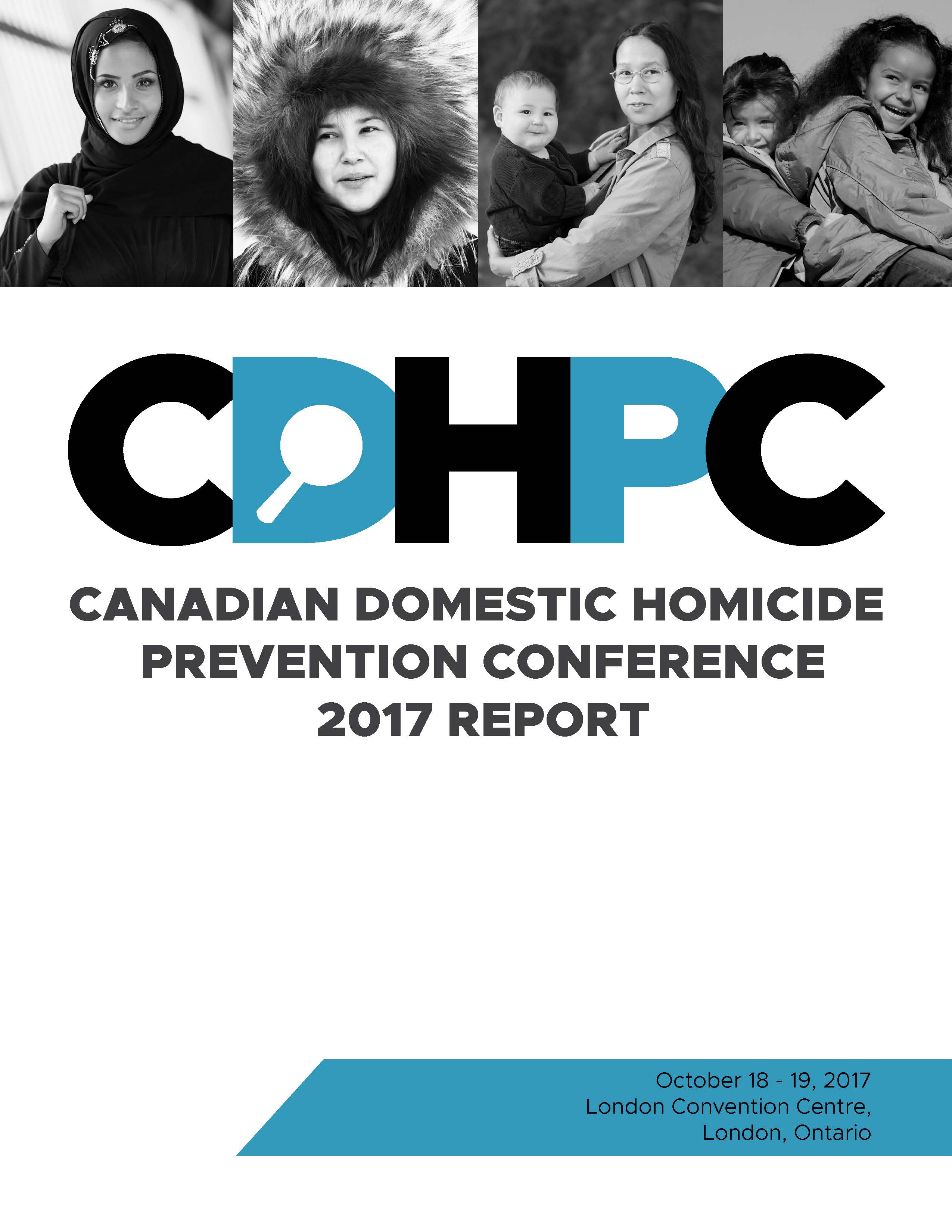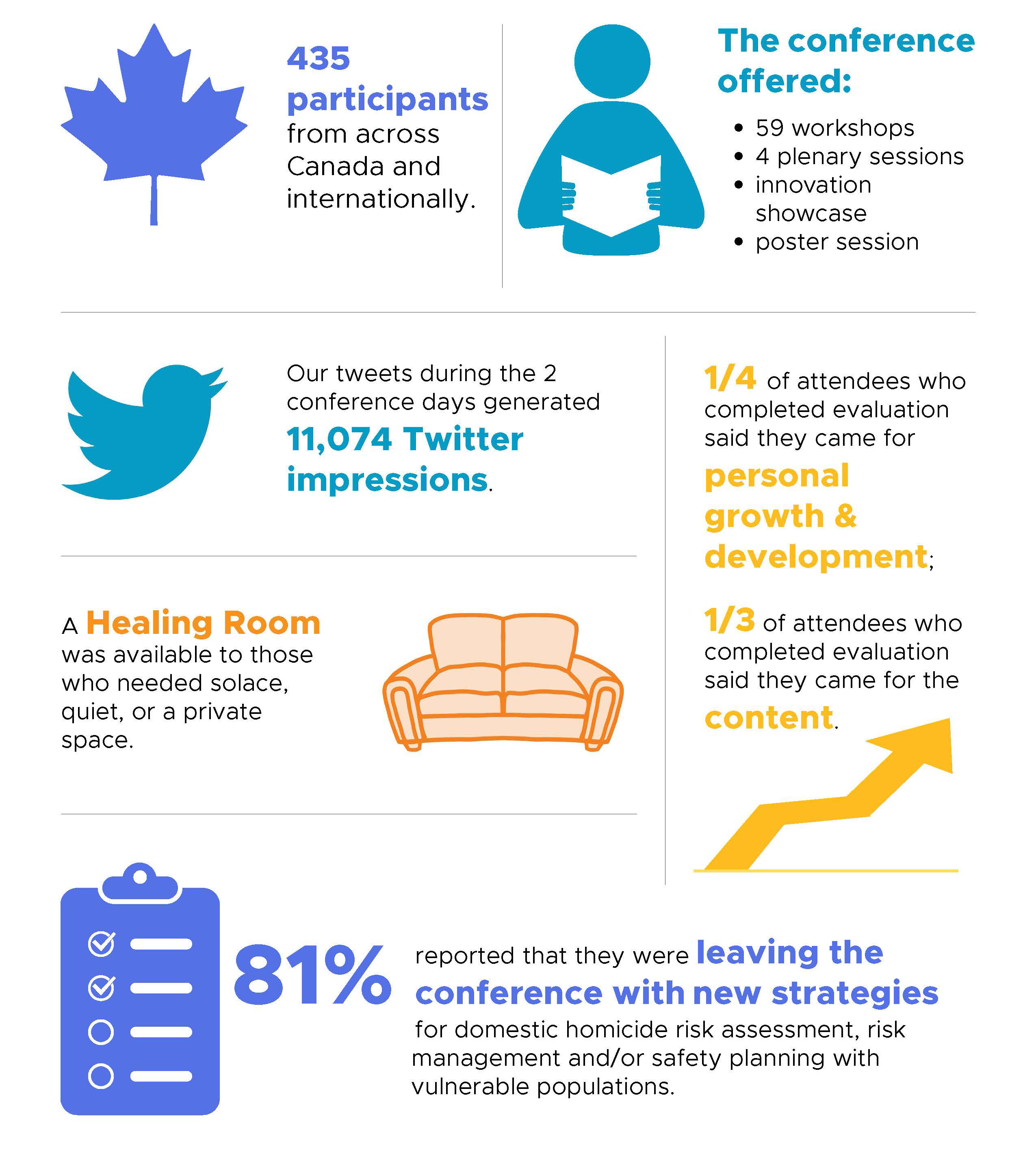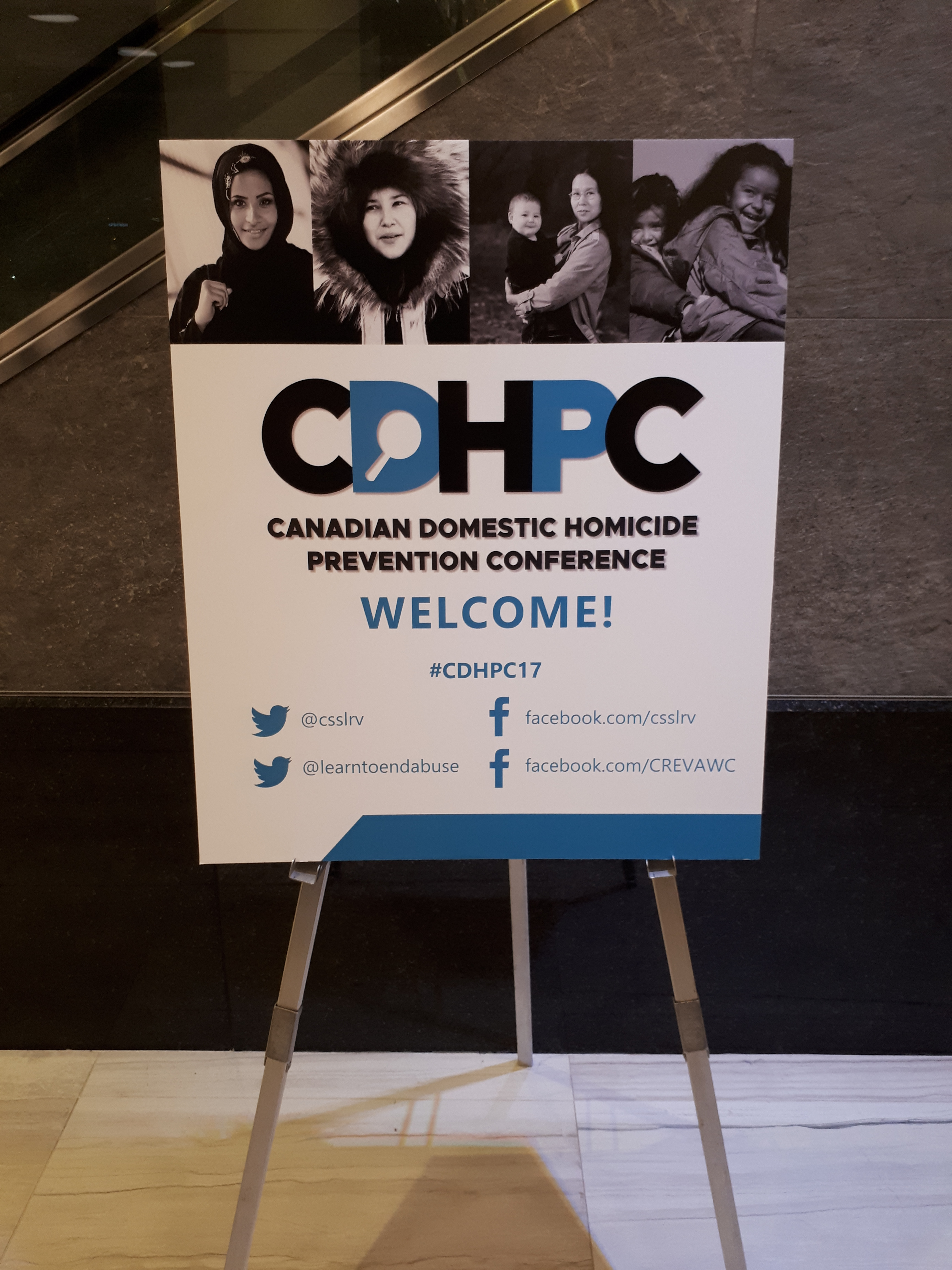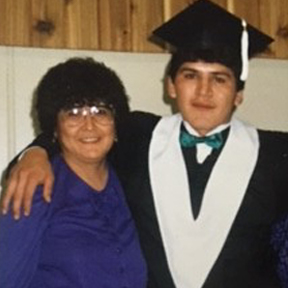 October 18 - 19, 2017
October 18 - 19, 2017
London Convention Centre, London, Ontario
Conference Highlights

- 35 participants from across Canada and internationally.
-
The conference offered:
- 59 workshops
- 4 plenary sessions
- innovation showcase
- poster session
- Our tweets during the 2 conference days generated 11,074 Twitter impressions.
- 1/4 of attendees who completed evaluation said they came for personal growth & development; 1/3 of attendees who completed evaluation said they came for the content.
- Healing Room was available to those who needed solace, quiet, or a private space.
- 81% reported that they were leaving the conference with new strategies for domestic homicide risk assessment, risk management and/or safety planning with vulnerable populations.
Canadian Domestic Homicide Prevention Initiative with Vulnerable Populations
The Canadian Domestic Homicide Prevention Initiative with Vulnerable Populations (CDHPIVP) is a five-year project funded by the Social Sciences Humanities Research Council (SSHRC)
- to conduct research on domestic homicides in Canada,
- identify protocols and strategies that will reduce risk,
- share this knowledge with the wider community.
The project, based on partnerships with more than 70 organizations and individuals, is conducting collaborative, cross-sectoral research to identify unique individual and community- level risk factors that may increase exposure to domestic violence (DV) and homicide for four populations:
- Indigenous peoples;
- rural, remote, and northern communities;
- immigrants and refugees;
- children exposed to DV.
The goal of the partnership project is the development of enhanced evidence-based information about effective risk assessment, risk management, and safety planning strategies to prevent lethal DV for these populations.
 The CDHPIVP hosted the Canadian Domestic Homicide Prevention (CDHP) conference on October 18 & 19, 2017 in London, Ontario. The conference brought together researchers, policy makers and practitioners working with children and adults to prevent and address DV and domestic homicide. The conference identified and addressed personal and structural risk factors for DV among the four vulnerable populations and promising practices for risk assessment, risk management, and safety planning. The conference offered four plenary sessions:
The CDHPIVP hosted the Canadian Domestic Homicide Prevention (CDHP) conference on October 18 & 19, 2017 in London, Ontario. The conference brought together researchers, policy makers and practitioners working with children and adults to prevent and address DV and domestic homicide. The conference identified and addressed personal and structural risk factors for DV among the four vulnerable populations and promising practices for risk assessment, risk management, and safety planning. The conference offered four plenary sessions:
- Domestic Homicides: Voices of Survivors;
- Safety Planning with Vulnerable Populations;
- Risk Assessment and Management with Vulnerable Populations;
- Domestic Homicide Reviews: What have we learned?
Additionally, the conference offered 59 workshops, posters highlighting current research, and an innovation showcase featuring several organizations and initiatives1. There were 435 participants at the conference with representation from all provinces and territories and internationally. Conference participants came from the health/addictions/mental health, police/justice/corrections, university/education, and Indigenous organizations. Other sectors represented at the conference include: child protection; family services; public sector/ government; and victim services/assistance/ survivors.
Opening Ceremonies
We thank Elder Myrna Kicknosway for offering a traditional opening ceremony for the conference. Myrna is from Walpole Island, Bkejwanong Territory. She is a Visiting Elder at Western University where she provides guidance and support to staff and students. Myrna also generously provided support throughout the conference in the Healing Room.
Plenaries
The Canadian Domestic Homicide Prevention conference hosted 4 plenaries. In total, 21 different speakers participated in the plenaries.
Domestic Homicides: Voices of Survivors
Most of the progress in preventing domestic homicide has come from the voices of surviving family members seeking answers from the community and service providers about what could have been done differently to save women’s and children’s lives. The courage of family members to publicly address these questions has forced us to better understand their stories and what opportunities may have been missed to intervene more effectively.
Mariann Rich spoke of her sister Shirley Parkinson who was killed by her husband in a rural and remote community of Saskatchewan. Mariann Spoke of the love and concern she had for her sister, and Shirley’s reluctance to share about what was going on in her relationship. Shirley faced many challenges and barriers to accessing services, particularly as she had a helping role in the community, and did not want to overlap her role as a service provider with that of a service user.
 Terri Brown spoke of her youngest sister Ada Brown who was killed after experiencing abuse by her intimate partner and others. Ada had sought medical attention three times in the days before she died for physical injuries she received. Ada was barely recognizable by her family members when she died. Her death originally was considered due to natural causes, even though she had experienced extensive injuries. She was considered just another dead Indian. Terri questioned whether Ada would still be alive if she had received intervention or support from any one of many service providers.
Terri Brown spoke of her youngest sister Ada Brown who was killed after experiencing abuse by her intimate partner and others. Ada had sought medical attention three times in the days before she died for physical injuries she received. Ada was barely recognizable by her family members when she died. Her death originally was considered due to natural causes, even though she had experienced extensive injuries. She was considered just another dead Indian. Terri questioned whether Ada would still be alive if she had received intervention or support from any one of many service providers.
Maha El-Birani immigrated to Canada with her family when she was two years old. She shared memories of her mother Sonia El-Birani who was killed by her husband in April 2012 after 29 years of oppression and abuse within their relationship. Maha’s father experienced severe and ongoing clinical depression and Sonia had to, at times, quit her job to look after her husband and small children. He was abusive towards his children throughout their lives. The family became increasingly isolated from the community and family, and faced criticism from the cultural community. After many years, Sonia’s children called the police, which led to interactions with various social service agencies many of which only exacerbated her husband’s anger and further isolated the family.
Marie-Paule McInnis spoke of the tragic loss of her two sons: Justin (2 years old) and Jerome (6 years old) when they were killed by their father in 1996 in the Gaspe Peninsula. Marie-Paule who lived several years in an abusive relationship found it difficult to seek help in a rural community where everyone knew each other. She did not feel supported or heard by her social worker and lawyer. Although there have been changes in policies and procedures in the years since the death of her sons, there is still much work to be done to support women and children living with domestic violence.
These women bravely shared stories of tragedy and immense loss. They identified a number of missed opportunities for service providers and others to intervene, communicate and collaborate. These lived experiences helped to provide context for providing domestic violence risk assessment, risk management and safety planning services and strategies.
Safety Planning with vulnerable populations
Abuse victims and their children require a safety plan to reduce the likelihood of repeated and potentially lethal violence. Finding safety at a point of crisis or a planned separation requires multiple agencies and courts collaborating, access to housing and other practical supports. These realities will vary across diverse communities and pose special challenges in accessing services on a timely basis. Safety may be a long term need as many domestic violence perpetrators continue to pose risks long after separation has occurred. In some cases, victims may continue to reside with the perpetrator and try to manage their safety within these circumstances. In either case, the impact of the abuse may continue to create trauma for victims and affect their autonomy in decision-making. Safety plans must be individualized reflecting on the individual’s community, identity, and circumstances, and reviewed regularly.
 Jacquelyn Campbell offered an overview of the Danger Assessment (www.dangerassessment.org), a risk assessment tool that assesses level of risk for homicide and provides information that helps women identify risks and need for safety planning strategies. The Danger Assessment has been modified and revised for various service providers) health care, high risk teams) and populations (pregnant women, immigrant women, same sex female couples, Indigenous women). A variety of safety planning tools and apps were described including iCAN; iHEAL; and myPLAN, many of which have been tailored to the populations focused on at the conference.
Jacquelyn Campbell offered an overview of the Danger Assessment (www.dangerassessment.org), a risk assessment tool that assesses level of risk for homicide and provides information that helps women identify risks and need for safety planning strategies. The Danger Assessment has been modified and revised for various service providers) health care, high risk teams) and populations (pregnant women, immigrant women, same sex female couples, Indigenous women). A variety of safety planning tools and apps were described including iCAN; iHEAL; and myPLAN, many of which have been tailored to the populations focused on at the conference.
The CDHPIVP defines safety planning as any strategy to protect domestic violence victims and those around the victims. Safety planning needs to be contextualized to situation, culture, and sources of discrimination.
 Deborah Doherty discussed the challenges of safety planning within a rural context, particularly in New Brunswick. Safety planning does not always mean an exit plan. Other strategies may be required to keep women safe when waiting for help such as police to arrive. Some factors that lead to domestic homicides in rural communities include access to firearms, alcohol/drug use. A majority of domestic homicides included a suicide by the abuser. Older women living with domestic violence experience increased vulnerability and risk of homicide. Safety planning strategies include providing trigger locks for firearms to keep children safe.
Deborah Doherty discussed the challenges of safety planning within a rural context, particularly in New Brunswick. Safety planning does not always mean an exit plan. Other strategies may be required to keep women safe when waiting for help such as police to arrive. Some factors that lead to domestic homicides in rural communities include access to firearms, alcohol/drug use. A majority of domestic homicides included a suicide by the abuser. Older women living with domestic violence experience increased vulnerability and risk of homicide. Safety planning strategies include providing trigger locks for firearms to keep children safe.
 Sepali Guruge identified safety planning challenges faced by immigrant and refugee women. Research on this topic is very limited. Most immigrant and refugee women are not aware of their rights when they come to Canada. Fear of deportation and language barriers prevent women from seeking help. Leaving a marital home is not an easy decision, journey or solution for immigrant women. We need to pay attention to culture and move beyond culture blaming.
Sepali Guruge identified safety planning challenges faced by immigrant and refugee women. Research on this topic is very limited. Most immigrant and refugee women are not aware of their rights when they come to Canada. Fear of deportation and language barriers prevent women from seeking help. Leaving a marital home is not an easy decision, journey or solution for immigrant women. We need to pay attention to culture and move beyond culture blaming.
 Dawn Lavell-Harvard discussed the role of matriarchal communities in maintaining safety in Indigenous communities before colonization, and the subsequent impact of colonization, patriarchy and misogyny on Indigenous communities. Racism and prejudice faced by Indigenous women from helping services such as police negatively impact the likelihood of women seeking help. The increased likelihood of apprehension of children by child protective service agencies prevents women from reporting violence. Unique challenges to Indigenous women living on rural and remote reserves were identified.
Dawn Lavell-Harvard discussed the role of matriarchal communities in maintaining safety in Indigenous communities before colonization, and the subsequent impact of colonization, patriarchy and misogyny on Indigenous communities. Racism and prejudice faced by Indigenous women from helping services such as police negatively impact the likelihood of women seeking help. The increased likelihood of apprehension of children by child protective service agencies prevents women from reporting violence. Unique challenges to Indigenous women living on rural and remote reserves were identified.
 Linda Baker discussed the importance of considering safety planning with children within their developmental context, cultural identity, geographical location, etc. We must consider carefully how to plan for safety effectively with children without making them responsible for their mother’s safety, and when the abuser continues to have visitation and access to the children. It is important to listen to children’s experiences and current coping strategies to help build safety plans. Core safety planning messages for children and youth include that they are not to blame, not responsible, that they should not get in the middle of violent situations, and if possible to call for help. Schools and other community agencies also have a role to play.
Linda Baker discussed the importance of considering safety planning with children within their developmental context, cultural identity, geographical location, etc. We must consider carefully how to plan for safety effectively with children without making them responsible for their mother’s safety, and when the abuser continues to have visitation and access to the children. It is important to listen to children’s experiences and current coping strategies to help build safety plans. Core safety planning messages for children and youth include that they are not to blame, not responsible, that they should not get in the middle of violent situations, and if possible to call for help. Schools and other community agencies also have a role to play.
Challenges to safety planning were identified in various workshops. Beyond a lack of resources, particularly in rural, remote, northern and Indigenous communities; many shelters experience chronic overcrowding and many communities lack access to domestic violence shelters or other affordable housing. Safety plans may be impacted by the lack of affordable or accessible transportation for women leaving violence, or seeking ongoing support or services. Within a trauma-and violence-informed framework, service providers should focus on strength-based approaches rather than adopting a deficit driven model. Some currently available resources and services may be ineffective due to their crisis-oriented response approach.
Risk assessment and management with vulnerable populations
There is increasing recognition about the importance of risk assessment in managing domestic violence cases. Proper risk assessments may help prioritize safety and risk management strategies but are often not completed on a regular basis due to lack of training and resources.
The CDHPIVP defines risk assessment as evaluating the level of risk of harm a victim (or others connected to the victim) may be facing including the likelihood of repeated violence or lethal (dangerous) violence, based on a professional’s judgment and/ or a structured interview and/or a tool (instrument) that may include a checklist of risk factors. The CDHPIVP does not offer a stance on the types of tools to be used. Although a number of tools have been identified and developed, few deal explicitly with the cultural and societal risk factors faced by Indigenous, rural, remote, northern, immigrant and newcomer women and children living with domestic violence.
Risk management is the use of strategies intended to reduce the risk presented by a perpetrator of domestic violence and can include treatment, monitoring, or supervision. These services and strategies must be culturally appropriate.
 Zoe Hilton discussed the use of risk assessment tools for assessing risk of domestic violence recidivism with a focus on actuarial tools. Actuarial tools estimate the probability that individuals will engage in future violence. Factors such as validation, generalization, communication and education available to use a tool should be considered when selecting a risk assessment tool. Examples of actuarial tools include the Ontario Domestic Assault Risk Assessment (ODARA), Domestic Violence Risk Assessment Guide (DVRAG).
Zoe Hilton discussed the use of risk assessment tools for assessing risk of domestic violence recidivism with a focus on actuarial tools. Actuarial tools estimate the probability that individuals will engage in future violence. Factors such as validation, generalization, communication and education available to use a tool should be considered when selecting a risk assessment tool. Examples of actuarial tools include the Ontario Domestic Assault Risk Assessment (ODARA), Domestic Violence Risk Assessment Guide (DVRAG).
 Randy Kropp discussed the use of structured professional judgement tools such as the B-SAFER. Factors to consider when using these kinds of tools include the nature and severity of violence, imminence, likelihood that severe violence may occur and who the likely victims may be. Risk assessment informs how to develop effective risk management plans. Risk management strategies should be feasible, practical, contextual and include identifying and targeting relevant risk factors; tailoring plans to individuals; link tasks to agencies/individuals.
Randy Kropp discussed the use of structured professional judgement tools such as the B-SAFER. Factors to consider when using these kinds of tools include the nature and severity of violence, imminence, likelihood that severe violence may occur and who the likely victims may be. Risk assessment informs how to develop effective risk management plans. Risk management strategies should be feasible, practical, contextual and include identifying and targeting relevant risk factors; tailoring plans to individuals; link tasks to agencies/individuals.
Mohammed Baobaid discussed challenges related to risk assessment and risk management within newcomer communities. People coming from collectivist cultures identify themselves with role oriented systems more strongly than rights-oriented frameworks. The extended family has a significant role within the collectivist context, and fear of causing shame within the family context are strong factors that prevent women experiencing domestic violence from seeking help. Preservation of the family is a priority. Family and community become more involved in protecting the family unit, often at the cost of the victims. When conducting risk assessment with people from immigrant and newcomer communities, cultural aspects, migratory experiences and role of religion should be considered not only as risk factors but as protective factors.
Information presented at workshops during the conference addressed limited knowledge service providers may have about the context of honour-based violence and the subsequent warning signs. Conditions related to immigrant and refugee women are not captured in a risk assessment (e.g. lack of social capital, immigration status, sponsorship, migration history, and social isolation). Often, service providers do not ask clients about their ethnic origin or migration history, and treat them similarly to people who have lived in Canada for a longer period of time.
 Josie Nepinak discussed the difference risks experienced by Indigenous women living with domestic violence. A study found that Indigenous women scored much lower on traditional risk assessment tools than non-Indigenous women. Factors to consider include intergenerational trauma, intergenerational disadvantage, contemporary disadvantage, and resilience
Josie Nepinak discussed the difference risks experienced by Indigenous women living with domestic violence. A study found that Indigenous women scored much lower on traditional risk assessment tools than non-Indigenous women. Factors to consider include intergenerational trauma, intergenerational disadvantage, contemporary disadvantage, and resilience
Contextual risk factors specific to Indigenous populations were identified and highlighted in various presentations throughout the conference. The history of colonization, residential schools and the sixties scoop, have had long term intergenerational impact on Indigenous people and communities. Systemic biases have contributed to over-representation of Indigenous people in the child welfare and criminal justice systems. Indigenous people also experience higher rates of substance use/abuse, poverty, food insecurity, inadequate housing, poor access to clean water and education are all factors to be considered when dealing with domestic violence in Indigenous communities. Attention must be paid to the implementation of recommendations of the Truth and Reconciliation Commission.
 Donna Martinson discussed the challenges to protecting women and children when applying outdated traditional court processes to modern justice system requirements. Judges need to understand the complex, multi-faceted nature of domestic violence and equality principles as outlined in the Charter of Rights and Freedoms, as well as the UN Convention on the Rights of the Child. Challenges are often faced when judges make conflicting decisions regarding women’s and children’s safety in criminal and family courts.
Donna Martinson discussed the challenges to protecting women and children when applying outdated traditional court processes to modern justice system requirements. Judges need to understand the complex, multi-faceted nature of domestic violence and equality principles as outlined in the Charter of Rights and Freedoms, as well as the UN Convention on the Rights of the Child. Challenges are often faced when judges make conflicting decisions regarding women’s and children’s safety in criminal and family courts.
 Crystal Giesbrecht identified risk factors experienced more commonly by women living in rural, remote and northern communities. Factors include geographic and social isolation, fewer services, limited access to transportation, access to firearms, concerns related to agrarian lifestyle such as leaving the farm business, concern for animal welfare, etc. Physical separation through no-contact orders may not be a practical response, particularly due to longer police response times in rural areas.
Crystal Giesbrecht identified risk factors experienced more commonly by women living in rural, remote and northern communities. Factors include geographic and social isolation, fewer services, limited access to transportation, access to firearms, concerns related to agrarian lifestyle such as leaving the farm business, concern for animal welfare, etc. Physical separation through no-contact orders may not be a practical response, particularly due to longer police response times in rural areas.
Domestic Homicide Reviews: What have we learned?
Across Canada, the US and several other countries, domestic violence death review committees are now common vehicles to promote understanding about how to better prevent domestic homicides. Consistent themes have emerged on improving public awareness, professional training, better access to services and improved coordination. However, there has been limited evaluation on the implementation of committee recommendations and how successful they have been in saving lives. Part of the challenge in preventing homicides is to recognize the complexity of the problem and the context of victim’s lives as experienced from an intersectional perspective. Review committees have increasingly recognized that there are unique strategies to prevent domestic homicides that consider various victim vulnerabilities and access to informed resources.
 Neil Websdale provided an overview of domestic violence fatality review teams in the United States. Recommendations for service provision are made because of this work but it has been challenging to measure the impact of this work. Claudette Dumont-Smith offered a statistical profile of Aboriginal women living in Canada and identified some socio-economic risk factors that may impact experiences of domestic violence. She called for a national Aboriginal Domestic Violence Death Review committee to learn more about and address the high rate of homicide among Indigenous women. Based on recommendations from domestic violence death review committees, Tracy Porteous talked about the importance and effectiveness of high-risk committees to help prevent domestic homicides. Jo-Anne Dusel spoke of intimate partner homicide in Saskatchewan. The first domestic violence death review was conducted in Saskatchewan in 2016 but with no promise that this work would continue. Death review committees have made recommendations to improve services and provide safety for men and women. Peter Jaffe spoke of the victimization of children in the context of domestic homicides. Children are killed: indirectly as a result of attempting to protect a child during a violent episode; directly as part of a murder-suicide plan; or directly as revenge against the partner who decided to end the relationship or for some other perceived betrayal. Research conducted by domestic violence death review committees have found that children are often overlooked when conducting risk assessment, risk management and safety planning even though multiple agencies may have been involved with these children prior to their deaths. Collaboration was identified as an important strategy moving forward to improve outcomes for safety plans, risk management and reducing domestic homicides.
Neil Websdale provided an overview of domestic violence fatality review teams in the United States. Recommendations for service provision are made because of this work but it has been challenging to measure the impact of this work. Claudette Dumont-Smith offered a statistical profile of Aboriginal women living in Canada and identified some socio-economic risk factors that may impact experiences of domestic violence. She called for a national Aboriginal Domestic Violence Death Review committee to learn more about and address the high rate of homicide among Indigenous women. Based on recommendations from domestic violence death review committees, Tracy Porteous talked about the importance and effectiveness of high-risk committees to help prevent domestic homicides. Jo-Anne Dusel spoke of intimate partner homicide in Saskatchewan. The first domestic violence death review was conducted in Saskatchewan in 2016 but with no promise that this work would continue. Death review committees have made recommendations to improve services and provide safety for men and women. Peter Jaffe spoke of the victimization of children in the context of domestic homicides. Children are killed: indirectly as a result of attempting to protect a child during a violent episode; directly as part of a murder-suicide plan; or directly as revenge against the partner who decided to end the relationship or for some other perceived betrayal. Research conducted by domestic violence death review committees have found that children are often overlooked when conducting risk assessment, risk management and safety planning even though multiple agencies may have been involved with these children prior to their deaths. Collaboration was identified as an important strategy moving forward to improve outcomes for safety plans, risk management and reducing domestic homicides.
Promising Practices presented in workshops
Living in an Abusive Relationship: Strategies for Staying Safer.
A safety planning tool developed by Public Legal Education and Information Service of New Brunswick (PLEIS-NB) to help women living with DV, especially outside of large urban areas, to self-assess their situation, strategically mitigate their risks, and access resources (with or without the help of a professional). Provides safety planning strategies for a variety of situations, contexts, and for children. www.legal-info-legale.nb.ca/en/safety-planning
ANANGOSH: Legal Information Manual and Training for Shelter Workers
This information and training program developed by the National Aboriginal Circle Against Family Violence is designed to inform Indigenous women and service providers of legal rights related to leaving a violence relationship. Legal tools for safety are discussed. Information is provided on the historical and social context that impacts Indigenous women in Canada, and a rights-based framework for addressing violence against Indigenous women. nacafv.ca/wp-content/uploads/2017/10/Legal-Information-Manual.pdf
FAST: Four Aspects Screening Tool
The FAST is a domestic violence screening and assessment tool developed for use with minority, newcomer, and immigrant groups, and within collectivist cultures. The tool focuses on four primary and potentially intersecting aspects that operate as sources of risk within families: (1) universal; (2) ethno-cultural; (3) migration experience; and (4) religious faith.
Good Lives Model of Offender Rehabilitation (GLM)
A framework of offender rehabilitation which uses strengths-based approach and is premised on the idea that we need to build capabilities and strengths in people in order to reduce their risk of reoffending. According to the GLM, people offend because they are attempting to secure valued outcome in their life. www.goodlivesmodel.com
Moving Forward
The Canadian Domestic Homicide Prevention conference is a knowledge mobilization strategy of the Canadian Domestic Homicide Prevention Initiative with Vulnerable Populations research project.
This initiative includes the following research projects:
- National domestic homicide databases: including information on domestic homicides in Canada which occur between 2010 and 2020; Surveys and interviews with service providers with four populations identified; regarding risk assessment, risk management and safety planning practices, particularly
- Interviews with proxies of domestic homicide victims to learn about missed intervention opportunities; and interviews with survivors of severe domestic violence regarding practices and strategies that were helpful in reducing or eliminating the violence;
- Comprehensive literature review;
- Knowledge mobilization activities.
Results of this research will be promoted through a variety of knowledge mobilization activities including a conference in 2021. Stay tuned at www.cdhpi.ca for information.
Thanks a lot! It was really interesting! Looking forward for another event like this organized by CDHPC to learn about the research results!
- Conference participant
The conference was coordinated by staff and students at the Centre for Research & Education on Violence against Women & Children. We acknowledge the support of the following people:
Elsa Barreto
Marcie Campbell
Randal David
Sakthi Kalaichandran
Joy Lang
Natalia Musielak
Casey Oliver
Laura Olszowy
Barbara Potter
Aleks Rakic
Katherine Reif
Mike Saxton
Anna-Lee Straatman
Sara Straatman
The Canadian Domestic Homicide Prevention Initiative with Vulnerable Populations is directed by:
Dr. Myrna Dawson, University of Guelph
Dr. Peter Jaffe, University of Western Ontario
Co-investigators:
Diane Crocker, Saint Mary’s University
Myriam Dubé, Université du Québec à Montréal
Mary Hampton, University of Regina
Nicole Letourneau, University of Calgary
Kate Rossiter, Simon Fraser University
Jane Ursel, University of Manitoba



